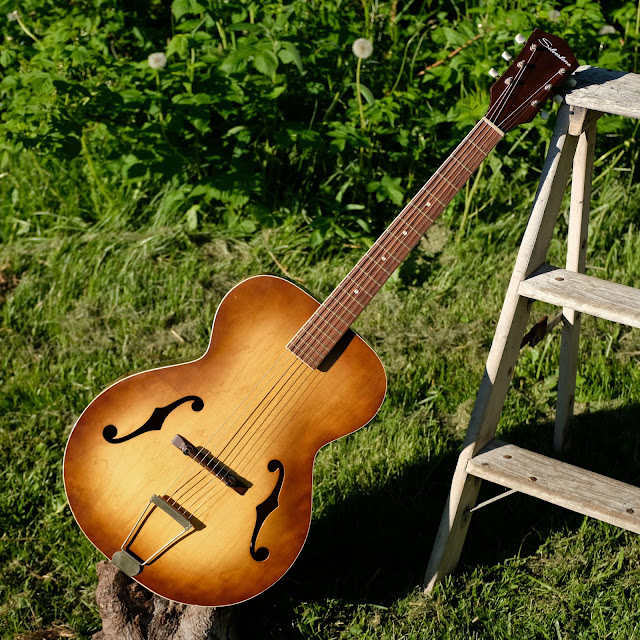1960s Kay-made Silvertone 619 Archtop Guitar
A local customer scored this for $75 and brought it in for repair. It's a very-typical Kay archtop product for the time and has an entirely-ply body mated to a poplar neck with an extra-long scale length. The Silvertone catalog called this a model 619 and the same basic type of Kay guitar was sold under many other names, too. It looks hot-to-trot starting at its iced-tea sunburst finish over maple veneer and, now that it's been fixed-up, plays hot, too.
Tonally, these guitars can be very mixed. Some of them have a tone reminiscent of a better '50s ply-top Gibson L-48 -- chunky and gutsy in the lower-mids but a little thinner on the top. Others just sound thin all over. This one's the former and sounds pretty good even with its 50w-11 stringing (as it has no truss rod and the scale is 25 3/4" which bumps the tension up). It's certainly no carved-top box, but it does chop-chording just fine.
Work included a funky neck reset (it'd been crudely bolted when it arrived), regluing most of the bass-side tonebar brace, a fret level/dress, compensation and better fitting for the original bridge, new adjustment posts for the bridge, cleaning, a little parts replacement work at the tuners, and a good setup.
Specs are: 25 3/4" scale, 1 5/8" nut width, 1 7/16" string spacing at the nut, 15 3/8" lower bout width, 11 3/8" upper bout, and 3 3/4" side depth. The neck is straight and the action is 3/32" EA and 1/16" DGBE at the 12th fret with room to go up an down at the bridge. The body is all thin, maple-veneered ply while the neck is poplar (steel-reinforced) with a rosewood fretboard and bridge. The board has a 10-12" radius and the back of the neck is a medium-sized C-shape.
Here are the two very-conspicuous fill-holes at the back of the neck. This came to the shop with a big bolt sticking out of it. I removed that, predrilled for another, and then shimmed-back the neck angle until I was happy with the fit and bridge height. Once I had it, I re-bolted the neck (this time with two) and glued it all in place, too. I then quickly filled-in behind the bolt-heads.
The neck joint had been damaged and shimmed-up willy-nilly beforehand -- as is usual for many old Kays as the dovetail joints were so terrible they were bound to fail.















Comments